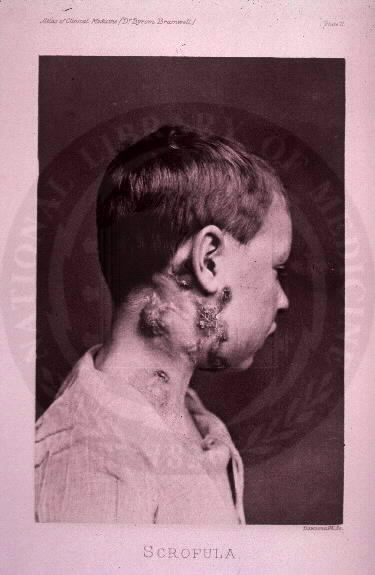King’s Evil and a Two-Hundred-Year-Old Charm June 29, 2017
Author: Beach Combing | in : Modern , trackbackThe King’s Evil (aka scrofula) was a form of tuberculosis that created horrific injuries on the skin’s surface, particular in the neck area. It could only be cured, many early modern French and British sufferers believed, by contact with royalty: a sufferer would go to the king or queen, be touched, and cured. The practice died out in the late seventeenth-century, British and French kings expressing, strangely enough, some reluctance to touch their poorest and most repulsive-looking subjects. However, their subjects continued to believe and, for some time after, considered objects from royalty to have a special healing power for scrofula. The latest reference that Beach has encountered comes from the far north of Britain, Shetland, when in 1838 (!!) many of coins of Charles I (obit 1649) were still being happily used.
For the cure of this fatal disorder nothing, even at the present day, is deemed so effectual as the Royal touch. And as a substitute for the actual living finger of royalty, a few crowns and half-crowns of the coinage of the first Charles, carefully handed down from father to son, have been effectual both here [in the parish of Mid and South Yell], and in every other parish in Shetland, towards removing this disease, and that to an extent which may appear somewhat incredible to many whose minds, in reference to the healing virtue still inherent in royalty, may be in a more sophisticated state, than those of her Majesty’s subjects in this latitude. Be this as it may, there are few localities in Shetland in which a living evidence is not to be found of one said to have been ‘cured by the coin,’ and who would instantly be pointed at as a sufficient evidence to warrant confidence in its efficacy, should it happen that a doubt at any time rested thereon. New Statistical Account of Scotland, XV (1845)
At first glance the coin is important because it has the king’s head and Charles I was an enthusiastic practitioner of scrofula healing: it gave him certainty about the absolute God-given rights he so clumsily claimed. However, there is more to it than this. Charles I regularly, on meeting sufferers, touched, prayed and then hung a coin of gold of silver around their necks, something he continued to do even while awaiting his execution. These coins were surely either those that had been given or those that there were claimed to have been given by the king himself: Charles I crowns were silver. Wonder if there are still some hidden away up there?
Can anyone do any better than a 200 year old charm on the cusp of the modern age*: drbeachcombing At yahoo DOT com
*Toynbee quotes Allen in relation to the loyal Shetlanders, and Beach repeats the sentence for those like him who support a better and older cause than the ‘good old cause’: ‘Though [his enemies] surreptitiously took away his earthly emoluments, and his Life into the bargain, they could not take the honour of this from him that gave it, nor the right thereof from him that received it.’
Bruce T writes in 30 June 2017: This region [south US] was heavily populated by Scots expelled from their land in 17th and 18th century. There is an old wart removing method that involves coins, either a silver quarter, or a nickle, made of the eponymous metal. Are they related? I have no idea, but it wouldn’t surprise me. The process was fairly simple, the wart remover would hold the coin on the wart, say a specific prayer and assure the sufferer the wart would be gone in a few days. My mother had one removed this way as a girl by a man with the appropriate surname of McDonald, the regional wart man. You won’t find a more Scottish name than that.



